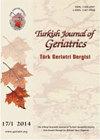80多岁老人择期血管内主动脉修复的中期结果:什么时候太老?
IF 0.3
4区 医学
Q4 GERIATRICS & GERONTOLOGY
Turkish Journal of Geriatrics-Turk Geriatri Dergisi
Pub Date : 2023-06-01
DOI:10.29400/tjgeri.2023.342
引用次数: 0
摘要
80岁老人的血管内主动脉修复效果尚不清楚。我们的目的是调查80岁老人在选择性血管内主动脉修复中的结果是否与年轻人不同。材料与方法:2013年1月至2022年1月,313例患者行选择性血管内主动脉修复术。从医院数据库中获得患者人口统计资料和围手术期及术后特征。主要目的是探讨80岁及以上患者的早期死亡率,并将其与80岁以下患者进行比较。次要目的是分析合并症因素。结果:80岁以下245例,80岁及以上68例。80岁以上人群早期死亡率为2.94%,其余人群为0.81%,两者差异无统计学意义(p = 0.24)。然而,在五年的随访中,80岁及以上的患者生存率明显较低。美国麻醉医师协会的评分被发现有助于预测晚期死亡风险和选择性血管内主动脉修复的患者选择。结论:由于耄耋老人身体脆弱,对并发症敏感,患者选择、审慎考虑预期寿命和临床评估是修复的关键。此外,年龄不应作为血管内主动脉修复治疗决策的独立排除标准。关键词:主动脉瘤;腹部;血管内手术;八旬老人。本文章由计算机程序翻译,如有差异,请以英文原文为准。
Midterm Outcomes of Elective Endovascular Aortic Repair in Octogenarians: When Is It Too Old?
Introduction: Endovascular aortic repair outcomes in octogenarians remain unclear. We aim to investigate whether the results for octogenarians differ from those of the younger population in elective endovascular aortic repair. Materials and Methods: From January 2013 to January 2022, 313 patients were treated with elective endovascular aortic repairs. Patient demographics and perioperative and postoperative features were obtained from the hospital database. The primary goals were to explore the early mortality rates of patients aged 80 years and older and compare them with those under 80. The secondary goal was to analyze the comorbid factors. Results: A total of 245 patients were under 80 years old, and 68 patients were 80 years and older. The early mortality rate was 2.94% in the octogenarians and 0.81% in the rest, and there was no significant difference between the two (p = 0.24). However, being 80 years and older led to a significantly lower survival probability at the five-year follow-ups. The American Society of Anesthesiologists’ score was found to help predict late mortality risk and patient selection for elective endovascular aortic repair. Conclusion: As octogenarians are fragile and sensitive to complications, patient selection, careful consideration of life expectancy, and clinical assessment are key to repair. Furthermore, age should not be an independent exclusion criterion in the endovascular aortic repair treatment decision. Keywords: Aortic Aneurysm, Abdominal; Endovascular Procedure; Octogenarians.
求助全文
通过发布文献求助,成功后即可免费获取论文全文。
去求助
来源期刊

Turkish Journal of Geriatrics-Turk Geriatri Dergisi
GERIATRICS & GERONTOLOGY-
CiteScore
0.60
自引率
0.00%
发文量
46
审稿时长
6-12 weeks
期刊介绍:
Turkish Journal of Geriatrics is a peer-reviewed journal. Official language of the journal is English. Turkish Journal of Geriatrics invites submission of Original Articles based on clinical and laboratory studies. Review Articles are published only after the invitation from the Editorial Board.
 求助内容:
求助内容: 应助结果提醒方式:
应助结果提醒方式:


